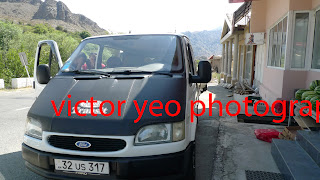It is the first Christian state in the world. In the 4th century, the kingdom of Armenia became the first nation to adopt Christianity as a state religion. Located at the crossroads of Western Asia and Eastern Europe, it is bordered by Turkey to the west, Georgia to the north, and Azerbaijan to the east, and Iran to the south. Its position between Europe and Asia is unique.
Armenia was conquered or invaded by many countries throughout the history, because it was never strong enough to defend itself.
Coming from Iran, i took a shared taxi towards Goris. The van traversed the windy mountainous road.
It is 53km to Goris, 285 km to Yerevan (the capital city).
 |
| This is the shared van that i took from the Iranian-Armenian border to Armenia proper. |
 |
One Iranian guy from the shared van. Yes, Iranians go on binge drinking (and all kinds of vice activities) once they are in Armenia. Armenia is like Vegas to them.
|
To see some of the nicest samples of historical urban architecture in Armenia, go to Goris. It is the second largest city in southern Armenia.
Arriving at the city square of Goris
A quiet street and rows of old houses in Goris
The Saint Gregory Cathedral is the biggest one of its kind in Goris.
One example of typical Soviet-style apartment in Goris
The next day, i went around the area. It is a mountainous region.
Ceremonial session was taking place in the church.
This is me at the Tatev monastery.
The Armenian boy in the taxi
The rugged scenery of the countryside around the house.
The Ararat Mountain can be seen along the road. Supposedly, Noah's ark landed on the mountains of Ararat. Ararat mountain is very important in Armenian culture. The mountain is now located in Turkey.
The Garni temple, it was first constructed in the year 115 (1900 years ago), and reconstructed many times. It was built in Greco-Roman style.
The monastery that is partially carved out of the mountain, the monastery of Geghard, a UNESCO world heritage site. The monastery was founded in the 4th century by Gregory the Illuminator.
A function room of the Geghard monastery, carved out from stone.
In the main chapel of the Geghard monastery.
A family praying inside the main chapel.
Yerevan
It is the capital of Armenia. The population of Yerevan is around 1.2 million people. Yerevan was named the 2012 world book capital by UNESCO.
The heart of Yerevan, is the Republic Square. It is endowed by singing fountains and it is the meeting point for all people.
The Yerevan Cascade, it is a combination of giant stairway and museum.
Contemporary art installation at Yerevan Cascade.
The singing fountains of Yerevan at Republic Square.
The Yerevan Opera Theater, opened in 1933.
The city hall of Yerevan
The Metro station of Yerevan
The Armenian family i met at Yerevan bus Station, the young guy is now in China for his PhD studies.
The immigration control point at the Armenia border, before going to Georgia.
































